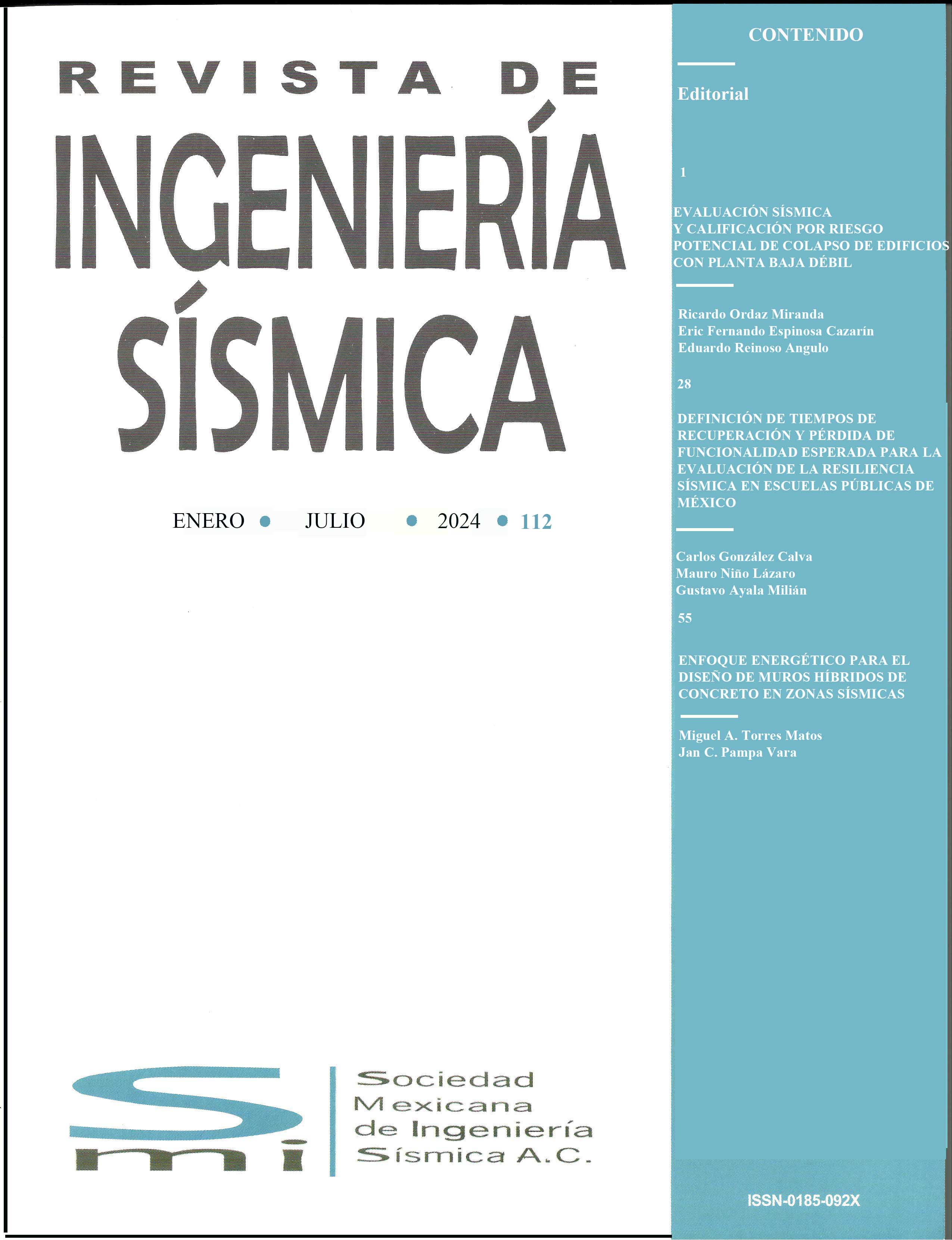MULTI-OBJECTIVE OPTIMUM DESIGN OF R/C FRAMES USING GENETIC ALGORITHMS
DOI:
https://doi.org/10.18867/ris.99.484Abstract
The application of multi-objective genetic algorithms for the seismic design of reinforced concrete frames is illustrated considering two objectives simultaneously. While the first objective of this study is to control the maximum inter-story drift, the second is to minimize the total cost of the frame. For this aim, the seismic effect is simulated through lateral forces for the analysis of the frames. To achieve a satisfactory seismic design, this work suggests the use of multi-objective evolutionary algorithms named Non-Dominated Sorting Genetic Algorithm (NSGA-II). The results suggest that genetic algorithm is a very useful tool for structural optimization; moreover, the designed frame buildings obtained are satisfactory in terms of seismic performance and economy.Downloads
References
Babaei, M y M Mollayi (2016), “Multi-objective optimization of reinforced concrete frames using NSGA-II algorithm”, Engineering Structures and Technologies, Vol. 8, No. 4, pp. 157-164. DOI: 10.3846/2029882X.2016.1250230
Back, B, T Laitinen y K Sere (1996), “Neural networks and genetic algorithms for bankruptcy predictions”. Expert Systems with Applications, Vol. 11, No. 4, pp. 407-413. DOI:10.1016/S0957-417496000553
Barraza, M (2013), “Algoritmos genéticos multi-objetivo y su empleo para el diseño sísmico óptimo de edificios de acero”, Tesis de Maestría (Directores de Tesis: Edén Bojórquez y Eduardo Fernández), Universidad Autónoma de Sinaloa.
Barraza, M, E Bojórquez, E Fernández-González y A Reyes-Salazar (2017), “Multi-objective optimization of structural steel buildings under earthquake loads using NSGA-II and PSO”, KSCE Journal of Civil Engineering. Vol. 21, pp. 488-500. DOI:10.1007/s12205-017-1488-7
Bojórquez, E, A Reyes-Salazar, S Ruiz y J Bojórquez (2013), “A new spectral shape-based record selection approach using Np and genetic algorithms”, Mathematical Problems in Engineering. DOI: 10.1155/2013/679026
Cazacu, R y L Grama (2013), “Structural optimization with genetic algorithms and particle swarm optimization”, Proceedings of the Annual Session of Scientific Papers IMT Oradea, Vol. 12, No. 22, pp. 19-22. DOI: 10.15660/AUOFMTE.2013-1.2778
Coello, C, F Hernández y F Farrera (1995), “Diseño óptimo de vigas de concreto reforzado mediante algoritmos genéticos”. 2do. Congreso Internacional de Investigación en Ciencias Computacionales, Zacatepec, México.
Deb, K, S Agrawal, A Pratap y T Meyarivan (2000), “A fast elitist non-dominated sorting genetic algorithm for multi-objective optimization: NSGA-II”, En International Conference on Parallel Problem Solving From Nature, Springer Berlin Heidelberg, September, pp. 849-858, DOI:10.1007/3-540-45356-3_83
Deb, K y S Gulati (2001), “Design of truss-structures for minimum weight using genetic algorithms”, Finite Elements Analysis and Design, Vol. 37, pp. 447-465. DOI:10.1016/S0168-874X(00)00057-3
Deb, K, A Pratap y T Meyarivan (2002), “A fast and elitist multiobjective genetic algorithm: NSGA-II”, IEEE Transactions on Evolutionary Computation, Vol. 6, pp. 182-197. DOI: 10.1109/4235.996017
Dede, T, S Bekiroglu y Y Ayvaz (2011), “Weight minimization of trusses with genetic algorithm”, Applied Soft Computing, Vol. 11, pp. 2565-2575. DOI: 10.1016/j.asoc.2010.10.006
Erbatur, F, O Hasançebi, İ Tütüncü y H Kilic (2000), “Optimal design of planar and space structures with genetic algorithms”, Computers and Structures, Vol. 75, pp. 209-224. DOI:10.1016/S0045-7949(99)00084-X
Goldberg, D (1989), Genetic algorithms in search, optimization, and machine learning, Addison-Wesley, Reading, MA.
Holland, J H (1975), Adaptation in natural and artificial systems. An introductory analysis with applications to biology, control and artificial intelligence, University of Michigan Press, Ann Arbor, Mich.
Kaveh, A, M Fahimi-Farzam y M Kalateh-Ahani (2015), “Performance-based multi-objective optimal design of steel frames structures: Nonlinear dynamic procedure”, Scientia Iranica, Vol. 22, pp. 373-387.
Koza, J R (1992), Genetic programming: on the programming of computer by means of natural selection, MIT Press.
Kripakaran, P, B Hall y A Gupta (2011), “A genetic algorithm for design of moment-resisting steel frames”. Structural and Multidisciplinary Optimization”, Vol. 44, No. 4, pp. 559-574. DOI:10.1007/s00158-011-0654-7
Kuri-Morales, A, y J Galaviz-Casas (2002), Algoritmos genéticos. Fondo de Cultura Económica/UNAM/IPN.
Leps, M y M Sejnoha (2003), “New approach to optimization of reinforced concrete beams”, Computers and Structures, Vol. 81, pp. 1957-1966. DOI: 10.1016/S0045-7949(03)00215-3
Leyva, H (2016), “Diseño de marcos de concreto reforzado con contraventeo restringido contra pandeo usando algoritmos genéticos”, Tesis de Maestría (Directores de Tesis: Edén Bojórquez y Eduardo Fernández), Universidad Autónoma de Sinaloa.
Lohn, J D y S P Colombano (1999), “A circuit representation technique for automated circuit design”. IEEE Transactions on Evolutionary Computation, Vol. 3, pp. 205-219. DOI: 10.1109/4235.788491
Paulay, T y M J N Priestley (1992), Seismic design of reinforced concrete and masonry buildings, John Wiley and Sons, Inc.
Pezeshk, S, C Camp y D Chen (2000), “Design of nonlinear framed structures using genetic optimization”, Journal of Structural Engineering, Vol. 126, No. 3, pp. 387–388. DOI:10.1061/(ASCE)0733-9445(2000)126:3(382)
Pique, J y M Burgos (2008), “Effective rigidity of reinforced concrete elements in seismic analysis and design”, The 14th World Conference on Earthquake Engineering, pp. 12-17.
Prendes-Gero, M B y J M Drouet (2011), “Micro-scale truss optimization using genetic algorithm”, Structural and Multidisciplinary Optimization, Vol. 43, pp. 647-656. DOI:10.1007/s00158-010-0603-x
Prendes, M, A García y J Del Coz (2006), “Design optimization of 3D steel structures: genetic algotihms vs. classical techniques”, Journal of Constructional Steel Research, Vol. 62, pp. 1303-1309. DOI: 10.1016/j.jcsr.2006.02.005
RCDF (2004), Reglamento de construcciones del Distrito Federal. Gaceta Oficial del Distrito Federal.
Reca, J y J Martínez (2005), “Genetic algorithms for the design of looped irrigation water distributions networks”, Water Resources Research, Vol. 42, W05416. DOI:10.1029/2005WR004383
Rivera-Vargas, D, J Terrón y C Arce (2014), “Estimación de la rigidez agrietada para el análisis sísmico en estructuras de concreto reforzado”, XIX Congreso Nacional de Ingeniería Estructural, SMIE.
Serrano, J (2016), “Optimizacion multi-objetivo de edificios de concreto reforzado mediante NSGA-II”. Tesis de Maestría (Directores de Tesis: Edén Bojórquez y Eduardo Fernández), Universidad Autónoma de Sinaloa.
Da Silva, E (2001), “Otimização de estruturas de concreto armado utilizando algoritmos genéticos”, Tesis Doctoral, Universidad de Sao Paulo.
Túpac, Y (2011), “Algoritmos evolutivos en optimización multiobjetivos (MOEA)”, XII Congreso Internacional de Informática y Sistemas.






